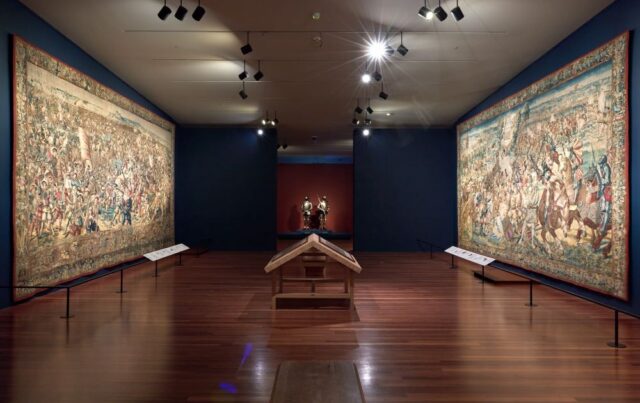The Fine Arts Museums of San Francisco will be the sole West Coast venue for Art and War in the Renaissance: The Battle of Pavia Tapestries. Tapestries and monumental examples of arms and armor will be on view, loaned from the Capodimonte Museum in Naples, Italy.
The Battle of Pavia Tapestries
The centerpiece of this exhibition is the newly conserved seven-part cycle of the Battle of Pavia Tapestries. Preparatory drawings on loan from the Louvre Museum provide a glimpse into the process of creation of the stories of Renaissance politics, history and art told in these pieces. The tapestries celebrate the victory of Holy Roman Emperor Charles V and the imperial army over the French army led by King Francis I. This pivotal battle ended the Italian war, which had begun in 1521, and stopped the French from encroaching into Italian territories. This decisive moment in European history took place almost exactly 500 years ago on Feb. 24, 1525, around the town of Pavia, outside of Milan.
A Group Endeavor Marking a Moment in Time
A story told in thread about this four-hour battle has survived despite the odds. Tapestries during the Renaissance were the art form of kings — much more expensive to create than a painting and not nearly as durable. The Battle of Pavia tapestries were made with silver and gold-wrapped thread along with wools and silks from around the world. The staggering scale of the tapestries — each one is as large as a muni bus — combined with the collaborative endeavor to create them, necessitated years of work to create one set. A single panel took nearly 18 months to produce.

Though half a millennium old, the Battle of Pavia Tapestries are in excellent condition, possessing an unexpected freshness and immediacy. Renaissance tapestries were a grand presentation of propaganda for kings and popes, but few have survived. Thomas P. Campbell, Director and CEO of the Fine Arts Museums, is also one of the world’s leading authorities on European tapestries. “The tapestries depict a pivotal battle that took place in February 1525, at which the army of Emperor Charles V roundly defeated the French army and captured the French king, Francis I, thereby changing the course of Italian history. The deciding factor in the battle was the handguns of the imperial troops, against which the armor of the French knights was no protection. Quite apart from the historical significance of the event, the tapestries are remarkable for the scale, realism and detail with which they depicted the events of this epochal battle.”
A Journey Through Time
The tapestries were created after designs by Bernard van Orley (ca. 1488-1541), an artist renowned for his portrait and religious paintings, as well as his stained glass and tapestry designs. A leading figure in Renaissance Brussels, he was a court artist to Margaret of Austria. He embraced advances coming out of Rome and was known for his careful study of Raphael’s designs for tapestries in the Sistine Chapel. He learned his trade from the German master Albrecht Durer, whose hypnotic detail and fine lines are echoed in Van Orley’s battle work. Sketches and compositional drawings evolved into full-scale paintings known as cartoons, which were then presented to the weavers. The presentation drawings are exclusive to the San Francisco stop of the exhibition tour.

The tapestries were in the collection of the Neapolitan d’Avalos family starting in the late 16th century, given to them by Don Juan of Austria (d. 1578). Along with works by artists including Titian, Luca Giordano, and Jusepe de Ribera, the tapestries were donated to the Italian state in 1862 by the last descendant of the d’Avalos family. The works came full circle as Fernando d’ Avalos, the Marquess of Pescara, had commanded the Habsburg army during the battle centuries before.
Since 1957, the works have called the Capodimonte Museum in Naples, Italy their home. Newly cleaned and restored, The Battle of Pavia Tapestries’ rare appearance reminds us of the great artistry behind these objects and the detailed depiction of a significant event in European history.
Sharon Anderson is an artist and writer in Southern California. She can be reached at mindtheimage.com





